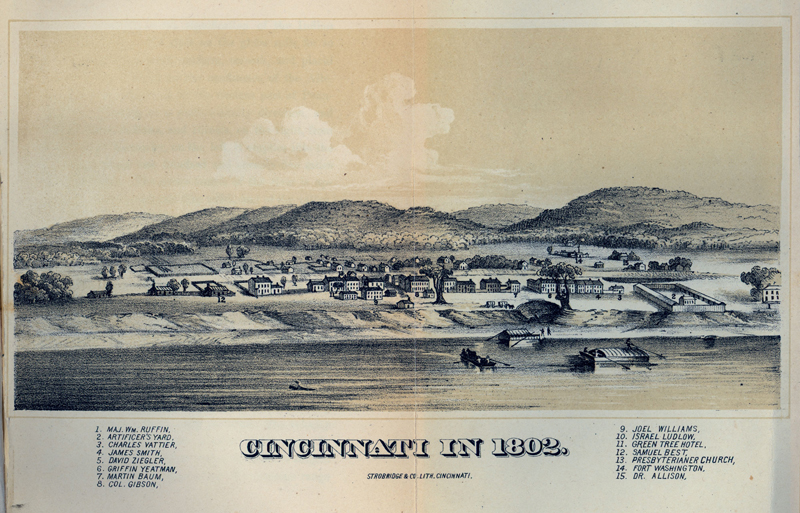
Geography, demographics, and a rapidly developing transportation system precipitated Ohio’s prominent role within the Underground Railroad. Ohio’s southern river boundary of 451 miles established the longest natural boundary between free and slave soil. Once the river was crossed freedom seekers funneled to lake port cities such as Cleveland and Sandusky, no farther than 250 miles away at its most distant point within the state on the Ohio River. A short 40 mile voyage across Lake Erie deposited fugitives in Canada where slavery had been outlawed by Great Britain since 1833.
Demographics also played a critical role in northern Ohio’s attraction. Land granted to Revolutionary War veterans from New England in the area known as the Firelands drew settlers from a region of the young country who sympathized with the plight of the slave. Many willingly provided food and shelter to fugitives while secluding them despite the risks. A number of dedicated men also piloted craft carrying freedom seekers across the lake.
This sentiment also encouraged both free and escaped slaves to settle in the area. Though receiving less recognition than their white counterparts, residents of African-American descent as Rev. Thomas Holland Boston, worked tirelessly at greater risk with the Underground Railroad.
We often hear that the Underground Railroad was not a railroad but an intricate network of operatives directing fugitives from station to station. However, by the early 1850’s Sandusky was regularly serviced by railway lines from the south which did indeed whisk a number of fugitives to Sandusky’s mile long waterfront to board vessels for freedom.

Harriet Tubman
Over the years documentation has been uncovered confirming Sandusky’s prominence during that volatile period. Yet even in the decade leading up to the Civil War Sandusky’s role was highly recognized. Harriet Beecher Stowe wove the city into her widely popular Uncle Tom’s Cabin storyline, released in 1852.
With a little imagination one can almost visualize the dramatic events from the past while standing in Facer Park. There’s the real Eliza dressed as a male holding the hand of her young son attired in girl’s clothing boarding the Arrow for the voyage to freedom. Or perhaps we see Josiah Henson with his family, believed to be Stowe’s model for her lead character Tom, waiting nervously for the rowboat west of town to transport them to a larger vessel, the Commerce, to carry them safely to Canada.
We squint to catch a glimpse of Tice Davids in 1831 pausing briefly in Sandusky after leaving his perplexed owner scratching his head in the riverfront town of Ripley and mumbling, It’s as if he found some road underground and totally disappeared. Many attribute that event to the unofficial naming of the Underground Railroad.
Looking northward we see the armada of ships over the years churning through the Sandusky Bay toward the channel leading to Lake Erie. There’s the Walk-in-the-Water, United States, Bay City, and the Mayflower.
Returning our focus to the mainland we see a fugitive sneak into C. C. Keech’s shop several store front’s to our east, where the hat maker and furrier provided temporary employment for escaped slaves. We also hear stories of Sanduskian Henry Merry providing work as wood cutters on his property south of town.
We encounter carriage maker George Reynolds, of mixed American Indian and African American descent, whose name surfaces frequently in Sandusky’s Underground Railroad lore. Reynolds maintained close ties with John Brown but resisted Brown’s pleas to join the ill-fated assault in Harpers Ferry.
Several blocks from the waterfront we pass the duplex on Lawrence Street where the Irvine brothers, John and Samuel live. In 1855 they received a coffin shipped to them in the suffocating heat of the summer via railroad. Fortunately they revived the man inside and within several days sent him to Canada. John’s namesake son fought with John Brown in Bloody Kansas.
In front of the Sloane House we recall an earlier occupant of the dwelling, Rush Sloane. The lawyer intervened in the 1852 attempt to return seven captured slaves to Kentucky. In a highly publicized court case in 1854, Sloane was convicted of breaking the 1850 Fugitive Slave Act and was fined $3000 plus court costs. In 1847 attorney Francis Parish was prosecuted under the 1793 Fugitive Slave law and fined $1000.
Several blocks to the north, we overhear a conversation between the Folletts at their home on the corner of East Adams and Wayne Streets. Oran, a well-respected Sanduskian and partner in the firm that published the 1858 Lincoln-Douglas Debates, is admonishing his wife, Eliza, for harboring fugitives. He represents the body of abolitionists who vehemently oppose slavery but feel the institution should be dissolved through the orderly legal process. Maintaining the long recognized privilege of getting in the last word, Mrs. Follett curtly rebuts, But husband, there is a higher law than man’s!”
The Underground Railroad Tour was developed based on a tour originally created for the Lake Erie Shores and Islands Visitors Bureau by the Sandusky Underground Railroad Education Center with the assistance of the Sandusky Old House Guild. Research assistance was provided by Eden Valley Enterprises, Elaine Lawson, and the late Janet Senne, a past president of the Erie County Historical Society. Ohio History recognized the important role that Erie County, as well as all of Ohio, played in the Underground Railroad. Their new addition includes the Follett House as Stop no. 14 of important URR sites in Ohio.
